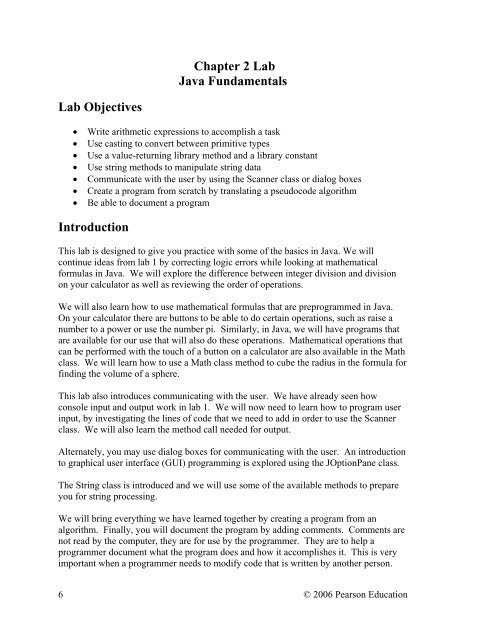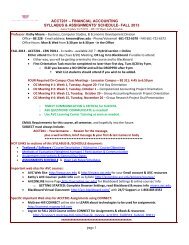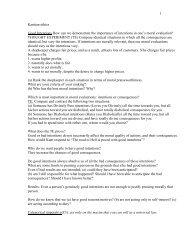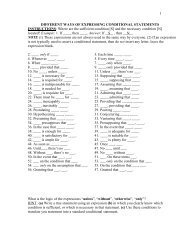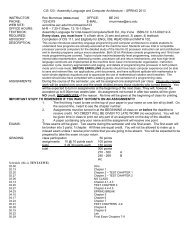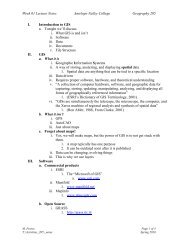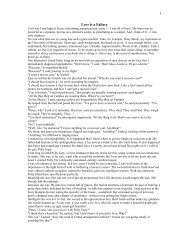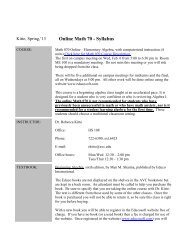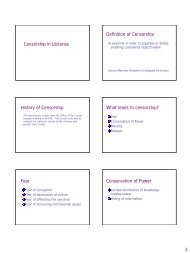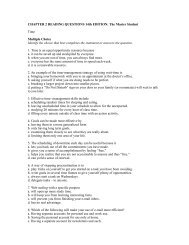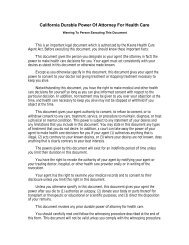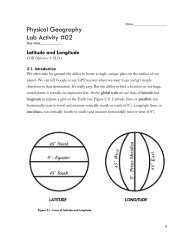Chapter 2 Lab Java Fundamentals Lab Objectives Introduction
Chapter 2 Lab Java Fundamentals Lab Objectives Introduction
Chapter 2 Lab Java Fundamentals Lab Objectives Introduction
Create successful ePaper yourself
Turn your PDF publications into a flip-book with our unique Google optimized e-Paper software.
<strong>Chapter</strong> 2 <strong>Lab</strong><strong>Java</strong> <strong>Fundamentals</strong><strong>Lab</strong> <strong>Objectives</strong>• Write arithmetic expressions to accomplish a task• Use casting to convert between primitive types• Use a value-returning library method and a library constant• Use string methods to manipulate string data• Communicate with the user by using the Scanner class or dialog boxes• Create a program from scratch by translating a pseudocode algorithm• Be able to document a program<strong>Introduction</strong>This lab is designed to give you practice with some of the basics in <strong>Java</strong>. We willcontinue ideas from lab 1 by correcting logic errors while looking at mathematicalformulas in <strong>Java</strong>. We will explore the difference between integer division and divisionon your calculator as well as reviewing the order of operations.We will also learn how to use mathematical formulas that are preprogrammed in <strong>Java</strong>.On your calculator there are buttons to be able to do certain operations, such as raise anumber to a power or use the number pi. Similarly, in <strong>Java</strong>, we will have programs thatare available for our use that will also do these operations. Mathematical operations thatcan be performed with the touch of a button on a calculator are also available in the Mathclass. We will learn how to use a Math class method to cube the radius in the formula forfinding the volume of a sphere.This lab also introduces communicating with the user. We have already seen howconsole input and output work in lab 1. We will now need to learn how to program userinput, by investigating the lines of code that we need to add in order to use the Scannerclass. We will also learn the method call needed for output.Alternately, you may use dialog boxes for communicating with the user. An introductionto graphical user interface (GUI) programming is explored using the JOptionPane class.The String class is introduced and we will use some of the available methods to prepareyou for string processing.We will bring everything we have learned together by creating a program from analgorithm. Finally, you will document the program by adding comments. Comments arenot read by the computer, they are for use by the programmer. They are to help aprogrammer document what the program does and how it accomplishes it. This is veryimportant when a programmer needs to modify code that is written by another person.6© 2006 Pearson Education
Task #1 Correcting Logic Errors in Formulas1. Download the file NumericTypes.java (see code listing 2.1) fromwww.aw.com/cssupport or as directed by your instructor.2. Compile the source file, run the program, and observe the output. Some of theoutput is incorrect. You need to correct logic errors in the average formula andthe temperature conversion formula. The logic errors could be due to conversionbetween data types, order of operations, or formula problems. The necessaryformulas areaverage = score 1+score 2numberOfScores5C = 9( F − 32)3. Each time you make changes to the program code, you must compile again for thechanges to take effect before running the program again.4. Make sure that the output makes sense before you continue. The average of 95and 100 should be 97.5 and the temperature that water boils is 100 degreesCelsiusTask #2 Using the Scanner Class for User Input1. Add an import statement above the class declaration to make the Scanner classavailable to your program.2. In the main method, create a Scanner object and connect it to the System.inobject.3. Prompt the user to enter his/her first name.4. Read the name from the keyboard using the nextLine method, and store it into avariable called firstName (you will need to declare any variables you use).5. Prompt the user to enter his/her last name.6. Read the name from the keyboard and store it in a variable called lastName.7. Concatenate the firstName and lastName with a space between them and store theresult in a variable called fullName.8. Print out the fullName.9. Compile, debug, and run, using your name as test data.10. Since we are adding on to the same program, each time we run the program wewill get the output from the previous tasks before the output of the current task.Task #2 (Alternate) Using Dialog Boxes for User Input1. Add an import statement above the class declaration to make the JOptionPaneclass available to your program.2. In the main method, prompt the user to enter his/her first name by displaying aninput dialog box and storing the user input in a variable called firstName (you willneed to declare any variables you use).© 2006 Pearson Education 7
3. Prompt the user to enter his/her last name by displaying an input dialog box andstoring the user input in a variable called lastName.4. Concatenate the firstName and lastName with a space between them and store theresult in a variable called fullName.5. Display the fullName using a message dialog box.6. Compile, debug, and run, using your name as test data.7. Since we are adding on to the same program, each time we run the program wewill get the output from the previous tasks before the output of the current task.Task #3 Working with Strings1. Use the charAt method to get the first character in firstName and store it in avariable called firstInitial (you will need to declare any variables that you use).2. Print out the user’s first initial.3. Use the toUpperCase method to change the fullName to all capitals and store itback into the fullName variable4. Add a line that prints out the value of fullName and how many characters(including the space) are in the string stored in fullName (use the method lengthto obtain that information).5. Compile, debug, and run. The new output added on after the output from theprevious tasks should have your initials and your full name in all capital letters.Task #4 Using Predefined Math Functions1. Add a line that prompts the user to enter the diameter of a sphere.2. Read in and store the number into a variable called diameter (you will need todeclare any variables that you use).3. The diameter is twice as long as the radius, so calculate and store the radius in anappropriately named variable.4. The formula for the volume of a sphere is4V = π r 33Convert the formula to <strong>Java</strong> and add a line which calculates and stores the valueof volume in an appropriately named variable. Use Math.PI for π and Math.powto cube the radius.5. Print your results to the screen with an appropriate message.6. Compile, debug, and run using the following test data and record the results.Diameter Volume (hand calculated) Volume (resulting output)225.4875,0008© 2006 Pearson Education
Task #5 – Create a program from scratchIn this task the student will create a new program that calculates gas mileage in miles pergallon. The student will use string expressions, assignment statements, input and outputstatements to communicate with the user.1. Create a new file in your IDE or text editor.2. Create the shell for your first program by entering:public class Mileage{public static void main(String[] args){// add your declaration and code here}}3. Save the file as Mileage.java.4. Translate the algorithm below into <strong>Java</strong>. Don’t forget to declare variables beforethey are used. Each variable must be one word only (no spaces).Print a line indicating this program will calculate mileagePrint prompt to user asking for miles drivenRead in miles drivenPrint prompt to user asking for gallons usedRead in gallons usedCalculate miles per gallon by dividing miles driven by gallons usedPrint miles per gallon along with appropriate labels5. Compile the program and debug, repeating until it compiles successfully.6. Run the program and test it using the following sets of data and record the results:Miles driven Gallons used Miles per gallon(hand calculated)2000 100500 25.5241.5 10100 0Miles per gallon(resulting output)7. The last set of data caused the computer to divide 100 by 0, which resulted inwhat is called a runtime error. Notice that runtime can occur on programswhich compile and run on many other sets of data. This emphasizes the need tothoroughly test you program with all possible kinds of data.Task #6 Documenting a <strong>Java</strong> Program1. Compare the code listings of NumericTypes.java with Mileage.java. You will seethat NumericTypes.java has lines which have information about what the programis doing. These lines are called comments and are designated by the // at thebeginning of the line. Any comment that starts with /** and ends with */ isconsidered a documentation comment. These are typically written just before a© 2006 Pearson Education 9
class header, giving a brief description of the class. They are also used fordocumenting methods in the same way.2. Write a documentation comment at the top of the program which indicates thepurpose of the program, your name, and today’s date.3. Add comment lines after each variable declaration, indicating what each variablerepresents.4. Add comment lines for each section of the program, indicating what is done inthat section.5. Finally add a comment line indicating the purpose of the calculation.Code Listing 2.1 (NumericTypes.java)/**This program demonstrates how numeric types and operators behave*///TASK #2 Add import statement here to use the Scanner class//TASK #2 (Alternate) Add import statment to use JOptionPane classpublic class NumericTypes{public static void main (String [] args){//TASK #2 Create a Scanner object here (not used for alternate)//identifier declarationsfinal int NUMBER = 2 ; // number of scoresfinal int SCORE1 = 100; // first test scorefinal int SCORE2 = 95; // second test scorefinal int BOILING_IN_F = 212; // freezing temperatureint fToC;// temperature in Celsiusdouble average;// arithmetic averageString output;// line of output to print out//TASK #2 declare variables used here//TASK #3 declare variables used here//TASK #4 declare variables used here// Find an arithmetic averageaverage = SCORE1 + SCORE2 / NUMBER;output = SCORE1 + " and " + SCORE2 + " have an average of "+ average;System.out.println(output);// Convert Fahrenheit temperatures to CelsiusfToC = 5/9 * (BOILING_IN_F - 32);10© 2006 Pearson Education
output = BOILING_IN_F + " in Fahrenheit is " + fToC+ " in Celsius.";System.out.println(output);System.out.println(); // to leave a blank line// ADD LINES FOR TASK #2 HERE// prompt the user for first name// read the user's first name// prompt the user for last name// read the user's last name// concatenate the user's first and last names// print out the user's full nameSystem.out.println();// to leave a blank line// ADD LINES FOR TASK #3 HERE// get the first character from the user's first name// print out the user's first initial// convert the user's full name to all capital letters// print out the user's full name in all capital letters// and number of characters in itSystem.out.println();// to leave a blank line}}// ADD LINES FOR TASK #4 HERE// prompt the user for a diameter of a sphere// read the diameter// calculate the radius// calculate the volume// print out the volume© 2006 Pearson Education 11


